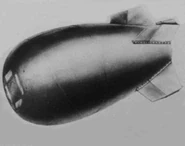
"Big Boy" explosion over Teng Sha Po, China
Big Boy Atomic Bomb was a Mark-4 atomic bomb dropped on Teng Sha Ho military base, outside of Dalian, Liaoning, China. Allied Command, under Matthew Ridgway, referred to the bomb as Bravo-Bravo, the NATO military code for B-B.
The atomic bombing took place during the Korean War, and was a major factor of the victory of the United States and South Korea in the war.
Approximately 150,000 Chinese and North Korean soldiers and 50,000 civilians were killed at the time of the explosion. This devastating loss for the Chinese army constituted a loss of 15% of their army, and a loss of 12% of the total Communist forces.
Largely responsible for the Chinese withdrawal in the Korean War, Big Boy was credited as saving at least 75,000 American soldiers, and 200,000 Allied soldiers and civilians.
Intelligence[]
The US Army Rangers had been issued a secret mission as early as November of 1950 to scout out the Chinese interior, notably in Manchuria, for the locations of Chinese troops in the Chinese interior, staging for an offensive in Korea.
The mission was two-fold:
- To predict when the Chinese would strike in an offensive.
- To locate an ideal location for bombings if that option was authorized.
By January of 1951, Supreme Allied Commander Douglas MacArthur ordered the Rangers to locate the largest concentration of Chinese troops in order to prepare for an atomic strike on China. When Truman finally authorized the strike under threat of an override, the Rangers had located Teng Sha Po, outside of Dalian, as the ideal location for the strike.
Drop-Zone[]
The Drop-Zone was honed in during the time leading up to the authorization of the atomic bombing by President Truman. Commander Matthew Ridgway, although skeptical of the overall effects of launching a nuclear assault on a Communist nation so closely aligned with the nuclear USSR, ordered investigation of Teng Sha Po, in addition to a few other sites for a potential drop.
Using the B-47 Stratojet for reconnaissance, the United State Air Force located the Chinese army at the Dalian base, and took a multitude of images from varied altitudes.
On April 20, Ridgway, in conjunction with Commander-in-Chief Truman, decided to use only 1 atomic bomb on the Chinese military installation of Teng Sha Po, near Dalian.
Timing[]
In order for the bombing of Teng Sha Po, in China, to be fully effective, it was decided that an offensive must be undertaken on the Korean Peninsula, to prompt an immediate Chinese withdrawal, and then take advantage of the grossly outnumbered North Koreans.
Ridgway had 150,000 fresh reinforcements in addition to his existing veteran corps prepared to take Kosong, and the offensive was timed with the bombing. In the morning of April 24, 1951, Col. Kenny Robertson took off from Okinawa's Kadena AFB, and soon arrived over Teng Sha Po, where he unleashed his 10,900 lb Mark 4 Atomic Bomb.
The casualties amounted to 150,000 military personnel killed, with 50,000 civilians also killed, a noted increase from Hiroshima and Nagasaki. The effect of the atomic bombing was China's withdrawal from the Korean War, and the eventual Allied victory on June 25, 1951.





